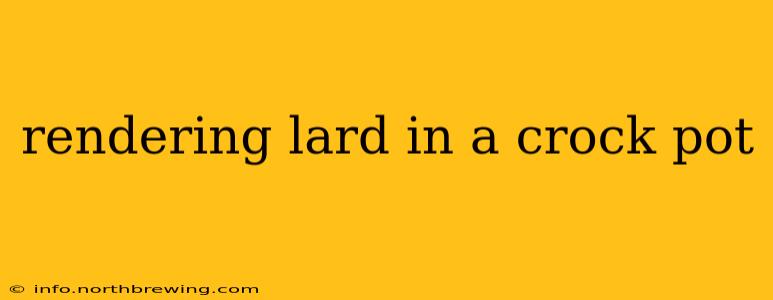Rendering lard at home might sound intimidating, but it's surprisingly easy, especially with a slow cooker. This method yields pure, high-quality lard perfect for baking, frying, or even skincare. Let's explore the process step-by-step, addressing common questions along the way.
What is Lard Rendering?
Lard rendering is the process of separating the fat from the connective tissues and other impurities in raw pig fat. This results in pure, clarified fat that's stable at room temperature and has a long shelf life. Using a crock-pot provides a gentle, hands-off method ideal for busy schedules.
What Cut of Pork Fat Do I Need for Lard Rendering?
The best cuts for lard rendering are those with a high fat content and minimal muscle tissue. Leaf lard, found around the kidneys and loins, is prized for its superior quality and delicate flavor, producing a very soft, white lard. Back fat is another excellent option, yielding a slightly firmer lard. Avoid cuts with excessive lean meat, as this will add impurities and potentially affect the taste and color of your rendered lard.
How Long Does it Take to Render Lard in a Crock-Pot?
Rendering lard in a crock-pot is a slow process, typically taking 8-12 hours on low or 4-6 hours on high. The exact time depends on the amount of fat you're rendering and the type of crock-pot you're using. The key is to cook the fat until it's completely rendered and the cracklings (crispy bits of rendered fat) are golden brown and crisp.
Can I Use a Different Type of Cooker for Rendering Lard?
While a crock-pot offers a convenient hands-off approach, you can also render lard using other methods like a Dutch oven on the stovetop or even in the oven. However, the crock-pot's low and slow cooking ensures even rendering and prevents burning.
How Do I Store Rendered Lard?
Proper storage is crucial for extending the shelf life of your rendered lard. Once cooled, pour the liquid lard into clean, airtight containers, such as glass jars or tins. Store it in a cool, dark place. Rendered lard can last for several months, or even longer, when properly stored.
What are the Benefits of Making Lard at Home?
Rendering your own lard offers several advantages:
- Quality Control: You know exactly what's going into your lard, ensuring it's free from additives and preservatives often found in commercially produced lard.
- Cost Savings: Buying raw pork fat is significantly cheaper than buying pre-rendered lard.
- Flavor: Homemade lard has a superior taste and texture compared to commercial alternatives.
What Can I Use Rendered Lard For?
Rendered lard is incredibly versatile:
- Baking: It makes pastries, biscuits, and pie crusts incredibly flaky and tender.
- Frying: Its high smoke point makes it ideal for frying foods like potatoes, chicken, and doughnuts.
- Skincare: Some people use lard as a natural moisturizer or salve.
How Do I Know When My Lard is Fully Rendered?
The lard is fully rendered when the cracklings are golden brown and crisp, and the liquid lard is clear and free of impurities. If there are still bits of fat attached to the cracklings, continue to cook for another hour or two on low.
What Happens if I Overcook My Lard?
Overcooked lard can become slightly darker in color and may have a slightly burnt taste. However, it will still be usable for most purposes, though possibly not for baking where a delicate flavor is desired.
Rendering lard in a crock-pot is a rewarding process, offering a delicious and versatile fat that can elevate your cooking and even your skincare routine. With a little patience, you'll have a supply of high-quality lard that far surpasses anything you can buy in the store.
